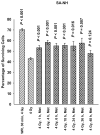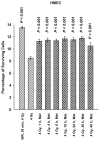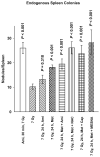Metformin exhibits radiation countermeasures efficacy when used alone or in combination with sulfhydryl containing drugs
- PMID: 24754562
- PMCID: PMC4080797
- DOI: 10.1667/RR13672.1
Metformin exhibits radiation countermeasures efficacy when used alone or in combination with sulfhydryl containing drugs
Abstract
Metformin, a biguanide drug used in the treatment of type II diabetes, was evaluated alone and in combination with amifostine, captopril, MESNA or N-acetyl-cysteine (NAC) for its ability to protect when administered 24 h after irradiation. Mouse embryo fibroblasts (MEF), human microvascular endothelial cells (HMEC) and SA-NH mouse sarcoma cells were exposed to 4 Gy in vitro. C3H mice were exposed to 7 Gy and evaluated utilizing an endogenous spleen colony assay system. Amifostine and WR1065, administered 30 min prior to irradiation, were used as positive controls. Treatment of MEF, HMEC and SA-NH cells with metformin elevated survival levels by 1.4-, 1.5- and 1.3-fold compared to 1.9-, 1.8- and 1.6-fold for these same cells treated with WR1065, respectively. Metformin (250 mg/kg) was effective in protecting splenic cells from a 7 Gy dose in vivo (protection factor = 1.8). Amifostine (400 mg/kg), administered 30 min prior to irradiation resulted in a 2.6-fold survival elevation, while metformin administered 24 h after irradiation in combination with NAC (400 mg/kg), MESNA (300 mg/kg) or captopril (200 mg/kg) enhanced survival by 2.6-, 2.8- and 2.4-fold, respectively. Each of these agents has been approved by the FDA for human use and each has a well characterized human safety profile. Metformin alone or in combination with selected sulfhydryl agents possesses radioprotective properties when administered 24 h after radiation exposure comparable to that observed for amifostine administered 30 min prior to irradiation making it a potentially useful agent for radiation countermeasures use.
Figures





Similar articles
-
Combining Pharmacological Countermeasures to Attenuate the Acute Radiation Syndrome-A Concise Review.Molecules. 2017 May 19;22(5):834. doi: 10.3390/molecules22050834. Molecules. 2017. PMID: 28534834 Free PMC article. Review.
-
Relationship between phosphorylated histone H2AX formation and cell survival in human microvascular endothelial cells (HMEC) as a function of ionizing radiation exposure in the presence or absence of thiol-containing drugs.Radiat Res. 2007 Jul;168(1):106-14. doi: 10.1667/RR0975.1. Radiat Res. 2007. PMID: 17723002 Free PMC article.
-
Delayed radioprotection by NFkappaB-mediated induction of Sod2 (MnSOD) in SA-NH tumor cells after exposure to clinically used thiol-containing drugs.Radiat Res. 2004 Nov;162(5):536-46. doi: 10.1667/rr3256. Radiat Res. 2004. PMID: 15624308
-
Maintenance of manganese superoxide dismutase (SOD2)-mediated delayed radioprotection induced by repeated administration of the free thiol form of amifostine.Radiat Res. 2008 May;169(5):495-505. doi: 10.1667/RR1194.1. Radiat Res. 2008. PMID: 18439041 Free PMC article.
-
Protection of normal tissues from the cytotoxic effects of chemotherapy and radiation by amifostine (WR-2721): preclinical aspects.Eur J Cancer. 1995;31A Suppl 1:S1-7. doi: 10.1016/0959-8049(95)00145-9. Eur J Cancer. 1995. PMID: 7577093 Review.
Cited by
-
Radiobiological Studies of Microvascular Damage through In Vitro Models: A Methodological Perspective.Cancers (Basel). 2021 Mar 9;13(5):1182. doi: 10.3390/cancers13051182. Cancers (Basel). 2021. PMID: 33803333 Free PMC article. Review.
-
Combining Pharmacological Countermeasures to Attenuate the Acute Radiation Syndrome-A Concise Review.Molecules. 2017 May 19;22(5):834. doi: 10.3390/molecules22050834. Molecules. 2017. PMID: 28534834 Free PMC article. Review.
-
Metformin effects on brain development following cranial irradiation in a mouse model.Neuro Oncol. 2021 Sep 1;23(9):1523-1536. doi: 10.1093/neuonc/noab131. Neuro Oncol. 2021. PMID: 34042964 Free PMC article.
-
Metformin Protects Against Radiation-Induced Heart Injury and Attenuates the Upregulation of Dual Oxidase Genes Following Rat's Chest Irradiation.Int J Mol Cell Med. 2018 Summer;7(3):193-202. doi: 10.22088/IJMCM.BUMS.7.3.193. Epub 2018 Oct 21. Int J Mol Cell Med. 2018. PMID: 31565651 Free PMC article.
-
Metformin ameliorates ionizing irradiation-induced long-term hematopoietic stem cell injury in mice.Free Radic Biol Med. 2015 Oct;87:15-25. doi: 10.1016/j.freeradbiomed.2015.05.045. Epub 2015 Jun 16. Free Radic Biol Med. 2015. PMID: 26086617 Free PMC article.
References
-
- Stone HB, Moulder JE, Coleman CN, Ang KK, Anscher MS, Barcellos-Hoff MH, et al. Models for evaluating agents intended for the prophylaxis, mitigation, and treatment of radiation injuries. Radiat Res. 2004;162:711–28. - PubMed
-
- Coleman CN, Stone HB, Moulder JE, Pellmar TC. Modulation of radiation injury. Science. 2004;304:693–4. - PubMed
-
- Weiss JF, Landauer MR. History and development of radiation-protective agents. Int J Radiat Biol. 2009;85(7):539–73. - PubMed
-
- Grdina DJ, Kataoka Y, Murley JS. Amifostine: Mechanisms of action underlying cytoprotection and chemoprevention. Drug Metabol Drug Inter. 2000;16:237–79. - PubMed
-
- Muaddi H, Chowdhury S, Vellanki R, Zamiara P, Koritzinsky M. Contributions of AMPK and p53 dependent signaling to radiation response in the presence of metformin. Radiotherapy and Oncol. 2013;108:446–50. - PubMed
Publication types
MeSH terms
Substances
Grants and funding
LinkOut - more resources
Full Text Sources
Other Literature Sources

